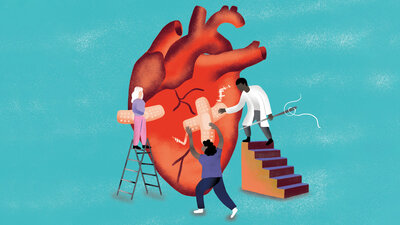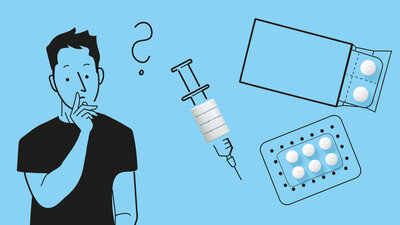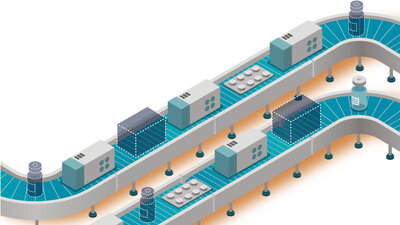Backaches - And How To Avoid Them!

Backaches: One of the most common complaints in the workplace.
© W&B/Rocio Montoya
Every third adult in Germany suffers from backache – often or even permanently. Another third occasionally. Women are more often afflicted than men, older people more often than young ones, the lower back twice as often as the upper back. Backaches are one of the most common reasons behind sick-leave in Germany.
However, we should not overdramatise these data, says Professor Karsten Schöller, spine surgeon at the Schön Clinic in Hamburg-Eilbek: ‘A painful back is not automatically ill. Most pain is like a cold. It comes and goes and is initially just a reaction to something not being right.’ Pain is thus an opportunity to change things around. For example in our everyday life that quite often is not very back-friendly. Lack of exercise, stress, sitting for hours on end, overweight – our back takes all that the wrong way.
‘Intrinsically, it is very robust. But sometimes, a lot of things concur’, Dr Anna-Katharina Doepfer of the Professional Association for Orthopaedics and Casualty Surgery (BVOU) confirms. The consequence: unspecified backache not linked to one concrete cause – the most common complaint with our back.
Relaxation: Good For Your Back
Backache can be caused in your head: Studies indicate that over 70 per cent of the people suffering from backache also suffer from stress. Psychosocial burdens like anxiety, discontent or overextension facilitate muscle tension and alter the processing of pain in the central nervous system and its neural pathways in the brain and the spinal cord. ‘It feels as if the volume control for pain is turned up’, neurosurgeon Schöller explains.
Work-related stress, problems in the family or relationship, financial worries – all that can trigger backaches or worsen them. Sometimes, even an undetected depression or anxiety disorder can be the cause. A vicious circle in the making: If the back ailment leads to less activity and a relieving posture, that in turn dampens the mood. ‘We start from the premise that psychosocial factors play an important role’, Professor Hendrik Schmidt argues, an expert for biomechanics currently conducting a major study on the causes of backache at Charité Berlin Hospital.
What everyone can do: realise that stress can play a major role, and actively search for relaxation. For instance with more leisure time, sleep and exercise, or with relaxation methods like meditation, yoga, tai chi, progressive muscle relaxation (PMR) or autogenous training. Studies have shown that mindfulness-based stress-reduction and cognitive behavioural therapy, too, can be more effective against unspecific pain than traditional methods like painkillers and physiotherapy. Mindfulness-based stress-reduction and cognitive behavioural therapy both help us to deal better with pain and to erase our pain memory. Mental stresses and strains should be mentioned when visiting the doctor.
Get Moving – Now!
Exercise against backache? It might sound painful in itself, but according to the latest medical knowledge, it is the best way to guard against or to alleviate dorsal pain. Further good news: ‘Nobody has to turn into a super athlete. A lot is achieved by integrating exercise into your everyday life and by moderate sporting activity two or three times a week’, says Professor Sven Oliver Eicker of the German Spine Society (DWG). In terms of training, the type of exercise is less important than the regularity.
‘I recommend to search for something you enjoy. Then, your motivation to stay involved is biggest – and thus also the effect’, Ute Merz, a spokeswoman for the German Association of Physiotherapy, explains. A strong trunk musculature is vital for a strong and flexible back. ‘The better your abdominals and back muscles work, the more effectively they protect against attrition and overburdening’, Merz explains. Most people lack stability in that area. Simple exercises can help to improve the musculature.
Basically, your back is delighted about moderate endurance sports like swimming backstroke or crawl-stroke, walking, running and cycling in combination with strength training. If you need some launching assistance for your training, you can attend back-training courses offered by health insurers and also some community colleges.
Generally, the experts agree that your back can deal with desk jobs if you exercise enough, your workplace is well-adjusted, the stress levels are appropriate and you don’t sprawl at your desk for hours on end: Get up at least once an hour (set your alarm!), make some phone calls standing up or walking about, go for a walk during your break and sit – from time to time – on a stool or gymnastics ball. ‘For your back, exercise probably also means not to stay in one position for too long. It needs change’, biomechanics expert Hendrik says. He wants to get a better understanding of the coherencies in his study.
A strong musculature supports and protects the spine. But exercise also helps to feed the intervertebral discs. ‘Since the buffers between our vertebral bodies do not get provided with nutrients by the blood vessels in great measure, they are dependent on activity’, orthopaedist Doepfer explains. Alternating between exposure and relaxation allows liquid nutrients to get to the intervertebral discs to keep them elasticated. Doepfer continues, quite colourfully: ‘With permanent physical inactivity, the intervertebral discs at some stage begin to look like flattened marshmallows.
Gentle Stimuli: Warmth And Cold
Whether in the form of balm, gel or heat plaster, hot-water bottle, cherry-pit pillow, bubble bath, mud pack or a visit to the sauna: Warmth has many appearances and is a popular measure against backache. And not without good reason: ‘Warmth widens the vessels, stimulates the blood flow and thus reduces muscle tension’, says physiotherapist Ute Merz. That can alleviate pain and tension and help to get you moving again. There is little scientific evidence, but we have at least some indications that warmth is helpful.
For example: Plasters and balms stimulating the blood flow did better in some small studies than placebos. However, we should not underestimate psychological factors: ‘Heat treatments are often connected to relaxation and self-care – and both are good ideas in case of backache’, orthopaedist Anna-Katharina Doepfer explains. Therefore, the experts agree: You can hardly go wrong with warmth against acute backache. ‘In most cases, it provides relief’, Doepfer continues. That, however, does not change the fact that it is merely a passive and accompanying measure that does not alter the causes of the pain.
Cold is more complicated. ‘Cold can alleviate pain in the short run, because the cold stimulus masks the pain stimulus’, physiotherapist Merz says. In case of backache without obvious cause, though, cold is not really helpful, as Merz explains. In case of acute pain combined with an inflammation, however, it is different: In such cases, swellings often cause pain by impacting upon the surrounding tissue and the neural pathways. Cold is also analgesic in case of pinched nerves, disc prolapse or sciatica. The same goes for rheumatic pain, where cryotherapy can help: For a few minutes, the patient steps into a cold chamber with temperatures of down to minus 110 degrees centigrade. However, Doepfer warns: ‘All cases where cold may help belong to a doctor. You should not experiment with that by yourself.’
Medication: Don’t Wait Too Long
Activity is the best medication against backache. But that is more easily said than done if you can hardly move because of the pain. ‘In that case, painkillers are indeed a reasonable measure to break the vicious circle of pain and relieving posture’, vertebrae expert Sven Oliver Eicker says. Active agents like ibuprofen, diclofenac and naproxen inhibit the production of endogenous pain and inflammation agents. Paracetamol or acetylsalicylic acid (ASA) might also help. Many drugs are available without a prescription.
However: Patients with chronic pre-existing diseases or with heart or kidney problems should consult with their doctor or pharmacist. If you are unsure about side-effects or drug interaction, you should also get professional advice. If you need painkillers more than three days in a row or on more than ten days per month, you should certainly consult with your general practitioner.
Painkillers are only advisable as an acute measure. If the backache recurs repeatedly over three months, you should also see an expert. In the short-term, however, painkillers allow for smoother movement which is good for your back and your musculature. ‘A short walk, for example, or some light exercise, but at least normal everyday movements’, physiotherapist Merz recommends. While many people are cautious with painkillers, it has been proven for backache patients that an early intake of painkillers is helpful, as it precludes that whole downward spiral of pain and inactivity.
In isolated cases, a syringe might help, often filled with cortisone and local anaesthetics. However, according to research studies, the effect is hardly better than that of a pill, and the risk is significantly higher, for instance with complications like abscesses or infections. Also, many patients are medically excluded from this type of treatment, for example because they are on anticoagulant medication. The guidelines for treating unspecified backache by now also advise against injections. ‘We have the clear-cut rule: pills before syringe’, Eicker explains. There are some cases where it may be useful to break up strong pain with an injection. ‘But that is far rarer than previously thought.’
In Good Hands: Massage and Manual Therapy
To clear up a common misunderstanding straight away: Massage and manual therapy are not the same, even if the terms are often used interchangeably. ‘Manual therapy is a physiotherapeutic measure treating functional disorders of muscles and joints’, physiotherapist Ute Merz explains. The techniques and touches might sometimes remind the patient of a massage, hence the confusion. But there is more behind manual therapy: The spine and its structures get examined in terms of agility and function. ‘According to its needs, areas can be mobilised and then stabilised with specific exercise’, Merz adds.
Whether it’s stretches, targeted massages or invigorating exercises – the treatment is based on a good qualification and plenty of experience. And it can achieve a lot: A meta-study that evaluated 47 relevant research studies has shown that manual therapy can be as effective as painkillers in fighting backache. In comparison with alternative therapies like acupuncture, manual therapy even did significantly better. ‘It is certainly worth a try’, orthopaedist Doepfer opines. Most health insurers cover the costs of manual therapy.
Massages, of course, also have their credentials. They facilitate relaxation and encourage blood flow, they can dissipate indurations and tension within the musculature, and they can increase general well-being. Studies have also shown that the aspect of being touched by another person can be healthful in itself. With simple gadgets, you can also massage the tissue yourself, with the help of a foam roller or a ball for instance. ‘It is important to approach cautiously and to try out whether the measure is indeed good for you’, Merz says. She has been treating patients who gave themselves heavy bruises with a fascia roll.
However pleasant massages and the like maybe – unfortunately, they do not have a lasting effect. Doepfer advises: ‘If you want to get rid of backache for good, you will not be able to avoid getting active yourself.’






